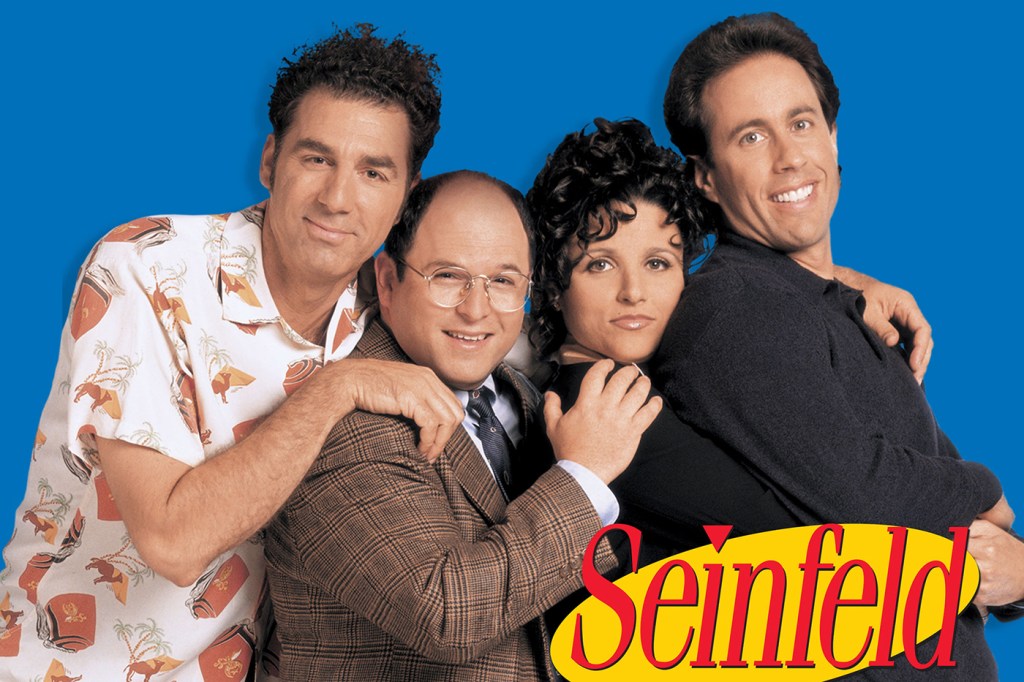Seinfeld may be gone, but your TV comedy wouldn’t be the same without it

Monday marked the 20th anniversary of Seinfeld’s finale. Even if you haven’t seen a single episode of the NBC sitcom or know hundreds of the show’s classic lines by heart, you likely have the program to thank for what you’re watching today.
I, for one, am a huge fan, having spent many hours watching re-runs, listening to the podcast Seincast, and even engaging in epic Seinfeld trivia battles. So, needless to say, I was thrilled to chat with Northeastern’s Joanne Morreale, associate professor of media and screen studies, who a few years ago wrote an essay examining the cultural spectacle of the Seinfeld finale.
Morreale noted that Seinfeld led the charge in ushering in unlikable characters to the small screen. Take, for example, the shows It’s Always Sunny in Philadelphia, Arrested Development, Two and a Half Men, and Two Broke Girls. “For the most part, television characters were people you could identify with and relate to, and then with Seinfeld you saw this change in a big way,” she said.
In the Seinfeld finale, the four main characters—Jerry, George, Elaine, and Kramer—are arrested and ultimately jailed for failing to help a carjacking victim. There are many other examples of their callous behavior throughout the show’s run, from Jerry finding trivial reasons for breaking up to George choosing cheap wedding invitations with toxic adhesive that kills his fiancée. There’s even an episode in which Elaine briefly ditches Jerry, George, and Kramer for a more likeable group of friends, only to be kicked out of the new group due to her intolerable behavior.
Here, Morreale examines Seinfeld’s impact, the spectacle of its final episode, and TV’s current landscape.
In your essay, you wrote that Seinfeld created a new lexicon among insiders that became “the social glue that bound together members of a cultural community.” In your view, what is Seinfeld’s lasting cultural impact?
I don’t think the lexicon had lasting cultural impact—I don’t think millennials today use that language or even get the references. I think its lasting impact was on the sitcom form—it ushered in the era of “cringe comedy” with unlikable characters, the idea that TV shows can be about “nothing” rather than having a problem or crisis that needs resolution. And, of course, the sitcom “family” was no longer nuclear but a group of friends. It predated Ellen and Friends, which were clones of Seinfeld. And today we have any number of these. There was also the way the show blended fiction and reality, especially in early seasons when Seinfeld the comedian began the show with his act.
Why did Seinfeld become a cultural phenomenon?
I’m not sure the show was a cultural phenomenon at the time it aired—though the finale became one because of the way it was hyped. This happens now whenever shows with high ratings go off the air. The Sopranos and Lost come to mind. But if you want to think about what made the show different and popular, it was a show that was made for a media-literate audience and that rewarded them for being in the know about its in-jokes and cultural references. I’m not sure many shows did that before Seinfeld.
In your essay, you noted the “cultural spectacle” surrounding Seinfeld’s finale and that it was a “unifying national moment.” Have we seen anything like this in television since then, or might we, with a show like Game of Thrones?
I think we will see something similar with Game of Thrones. It will be extensively hyped and people will have parties and gatherings. And the ending will be shrouded in secrecy. Lost was similar—they shot three different endings to keep it a secret. And the end of The Sopranos has become legendary.
Which current shows do you discuss most with your students?
I teach a TV text class where the most popular show we watch is Breaking Bad. I do a lot of classes on complex narratives and how they feature antiheroes that break with traditional processes of identification. I also show the pilot of The Sopranos, a show that many students have not seen but they appreciate. I also use Deadwood to talk about the deconstruction of the Western myth.
How have streaming services such as Netflix shaped communal TV experiences?
We don’t really have the “water cooler show.” We’ve lost that to some extent. But with social media, you have these really strong communities that talk and tweet about it together all the time. TV writers even look at social media and see what people are saying, and in some cases they may change plot points based on what’s being said. The TV landscape is so much more fragmented today. There’s no way you can ever watch everything. It’s contributed somewhat to the polarization in our society. Years down the road, you won’t have those touchstones. The show M*A*S*H had 105 million people watch the finale—you’ll never match that again.
Today, what shows you watch are almost like an identity category. Take Game of Thrones. Some people can’t get enough of it, others don’t like the violence or fantasy. It can tell you a lot about people, what TV shows they watch.





